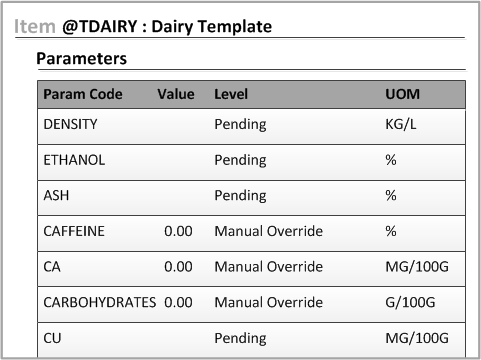Set templates
A set template enables you to reduce the amount of parameter data that is displayed in Optiva. The template overrides the data filters.
The name of the template matches the name of a set, but the template
name has the
@T prefix. For example, if the set is named
FOOD, the template name is
@TFOOD.
You can associate an object with a set template. In this case, you
assign the set code (FOOD) to the object. Only the parameters
that are assigned to the template (@TFOOD) are available for
the object.
The first row in this table shows the parameters that are associated
with the Rollup filter for the
GLOBAL set code. There is no template for the
GLOBAL set code.
The second row in this table shows the parameters that are associated
with the Rollup filter for the
FOOD set code. The
@TFOOD template overrides the parameters that are
normally available for the Rollup filter if the object is assigned to the
FOOD set.
| Lab | Filter | Template | Set Code | Parameters displayed in object |
|---|---|---|---|---|
| Global | Rollup | (none) |
GLOBAL
|
|
| Global | Rollup |
@TFOOD
|
GLOBAL
|
|
The order of parameters in filters is used for specifications.
See Data filters.
The collection of parameters for an object is based on the set
classifications of the object. If an object has multiple set classifications
that correspond to templates, then the parameters for all set templates are
merged. This item is assigned to the
FOOD and
HEALTH sets. The item includes parameters from both
@TFOOD and
@THEALTH templates.
| Template | Object’s set codes | Parameters displayed in object |
|---|---|---|
@TFOOD
|
|
|
@THEALTH
|
|
|
A template looks like a regular object, such as a formula, item, or project. The differences are:
- The name is a set code with
@Tprefix. - All parameters are displayed for the lab. There are no parameter filters.
- You use the Value column to select parameters to include in a template by putting any value there; the value itself does not display in the object.
